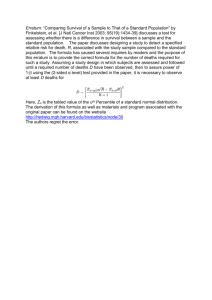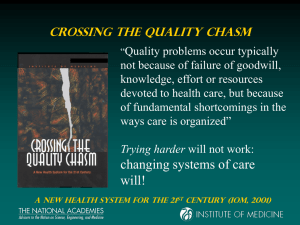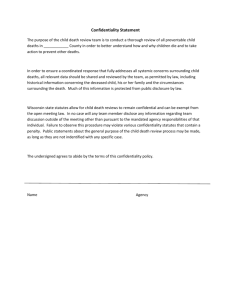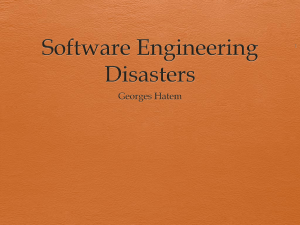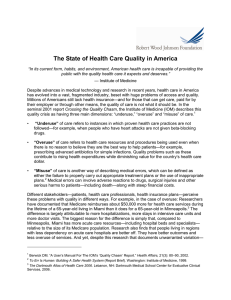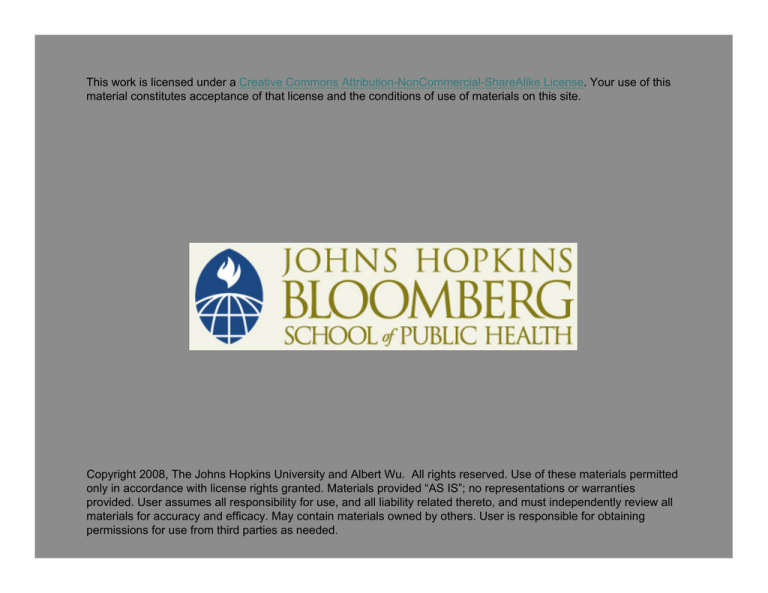
This work is licensed under a Creative Commons Attribution-NonCommercial-ShareAlike License. Your use of this
material constitutes acceptance of that license and the conditions of use of materials on this site.
Copyright 2008, The Johns Hopkins University and Albert Wu. All rights reserved. Use of these materials permitted
only in accordance with license rights granted. Materials provided “AS IS”; no representations or warranties
provided. User assumes all responsibility for use, and all liability related thereto, and must independently review all
materials for accuracy and efficacy. May contain materials owned by others. User is responsible for obtaining
permissions for use from third parties as needed.
The IOM Report(s)
Albert W. Wu, MD, MPH
Johns Hopkins University
Section A
To Err Is Human
Prior to “The” IOM Report
National Halothane Study
Anesthesia Patient Safety Foundation
Celebrated cases
− Libby Zion
− Betsy Lehman
Harvard Medical Practice Study
4
Institute of Medicine Report (1999)
The problem is large
Health care workers are not to blame
Errors and safety are caused by systems
5
A Systems Approach Is Necessary
Errors are a leading cause of death and injury
Blaming an individual does not change the factors and
conditions that contribute to errors, and the same error is
likely to recur
Preventing errors and improving patient safety requires a
systems approach
Leadership, knowledge, and tools are needed
6
Lesson 1: The Problem Is Large
44,000–98,000 deaths annually
7,000 death from medication errors
Total cost of preventable adverse events is between $17 and
$29 billion
Relative silence surrounds the issue
7
Lesson 1: The Problem Is Large
44,000–98,000 deaths annually
7,000 death from medication errors
Total cost of preventable adverse events is between $17 and
$29 billion
More than from motor vehicle accidents, breast cancer, or
AIDS
8
Institute of Medicine Report, November 29, 1999
Errors kill 44,000–98,000 in U.S. hospitals each year
120,000
Accidental Deaths in the U.S.
An estimated one million people are injured by errors during
hospital treatment each year and 120,000 people die as a
result of those injuries, according to a study led by Lucian
Leape of the Harvard School of Public Health. Here’s how
that number compares with other causes of accidental death
in the United States.
100,000
80,000
60,000
40,000
20,000
0
120,000
medical
error deaths
43,649
motor
vehicle deaths
Source: The Philadelphia Inquirer and the National Safety Council.
14,986
3,959
deaths drowning
from falls
deaths
329
commercial
aviation deaths
9
Lesson 2: The Workers Are Not to Blame
Blame
Pursuit of
“excellence”
Denial
The Vulnerable System Syndrome
Source: Reason. (1990).
10
Lesson 3: Errors and Safety Result from System Factors
Institutional
Hospital
Departmental Factors
Work Environment
Team Factors
Individual Provider
Task Factors
Patient Characteristics
11
A Comprehensive Approach
Needed to achieve a 50% reduction in errors over 5 years
Leadership at level of government and health care
organizations
Enhance knowledge and tools
Break down legal and cultural barriers that impede safety
improvement
12
Errors Can Be Prevented
To err is human, but errors can be prevented
Safety is a critical first step in improving quality of care
13
December 7, 1999
December 7, 1999: President Clinton directed the Quality
Interagency Coordination Task Force to respond with a
strategy to identify prevalent threats to patient safety and
reduce medical errors
− Goal: Reduction in medical errors by 50% in next 5 years
14
QuIC Report to the President
Report of the Quality Interagency Coordination Task Force
(QuIC) to the President, February 2000
− Doing What Counts for Patient Safety: Federal Actions to
Reduce Medical Errors and Their Impact
15
Steps Toward Increasing Safety
Center for Patient Safety formed within the Agency of
Healthcare Research and Quality
Funding provided for reporting systems
Greater attention on patient safety paid by regulators and
accreditors
Greater emphasis paid to patient safety within health care
organizations
16
BMJ Devotes Issue to Medical Error
British Medical Journal,
March 18, 2000
17
Ladies’ Home Journal Publishes Article on Medical Error
18
Section B
Crossing the Quality Chasm
A New Health System for the 21st Century
“Americans should be able to count on
receiving care that uses the best
scientific knowledge to meet their
needs, but there is strong evidence that
this frequently is not the case. The
system is failing because it is poorly
designed. . . . For too many patients, the
health care system is a maze, and many
do not receive the services from which
they would likely benefit.”
20
Optimal Patient Outcome System
Care System
Supportive
payment and
regulatory
environment
Organizations
that facilitate
the work of
patient-centered
teams
High performing
patientcentered teams
Outcomes:
– Safe
– Effective
– Efficient
– Personalized
– Timely
– Equitable
Redesign Imperatives: Some Challenges
– Reengineered care processes
– Effective use of information technologies
– Knowledge and skills management
– Development of effective teams
– Coordination of care across patient conditions,
services, sites of care over time
Source: The Institute of Medicine. (2001). Crossing the quality chasm.
21
High Quality of Care
Safe
Effective
Patient-centered
Timely
Efficient
Equitable
22
Simple Rules for the 21st-Century Health Care System
Current approach
New rule
Care is based primarily on visits
Care is based on continuous healing
relationships
Professional autonomy drives
variability
Care is customized according to
patient needs and values
Professionals control care
The patient is the source of control
Information is a record
Knowledge is shared and information
flows freely
Decision making is based on training
and experience
Decision making is evidence-based
Do no harm is an individual
responsibility
Safety is a system property
Secrecy is necessary
Transparency is necessary
The system reacts to needs
Needs are anticipated
Cost reduction is sought
Waste is continually decreased
Preference is given to professional
roles over the system
Cooperation among clinicians is a
priority
23
Crossing the Quality Chasm
Redesigning the health care delivery system will require
changing the structures and processes of the environment in
which health professionals and organizations function in four
main areas
24
Four Changes in Structure and Process
Applying evidence to health care delivery
Using information technology
Aligning payment policies with quality improvement
Preparing the workforce
25
Evidence-Based Practice
Move from practice based on tradition to practice based on
evidence
26
Information Technology
Electronic health records
Reporting systems
Automated treatment delivery systems
27
Payment Policy
Public and private purchasers should develop payment
policies that reward quality
Current methods provide little financial reward for
improvements
Compensation methods should be more closely aligned with
quality-improvement goals
28
Preparing the Workforce
Change the way health professionals are trained
Modify regulation and accreditation
Use the liability system to support changes in care delivery
29
Essential Reading
To Err Is Human: Building A Safer Health System. National
Academies Press, 2000
Crossing the Quality Chasm: A New Health System for the 21st
Century. National Academies Press, 2001
30

